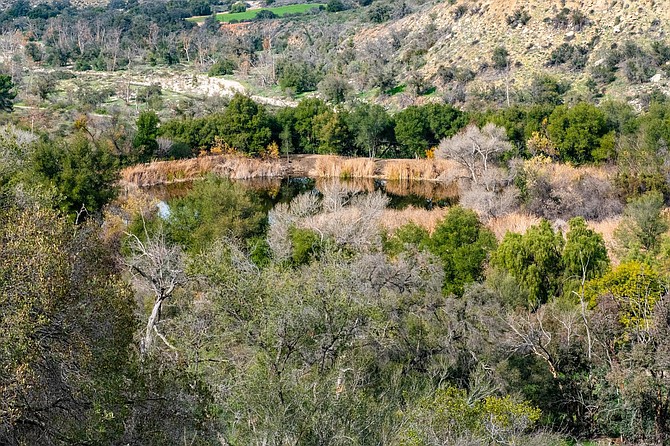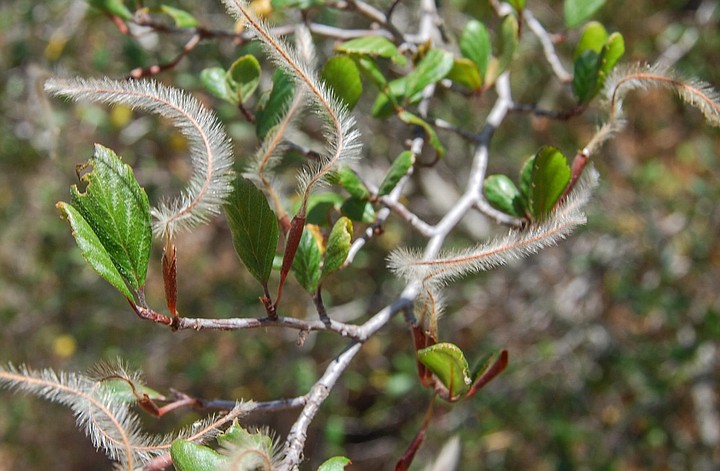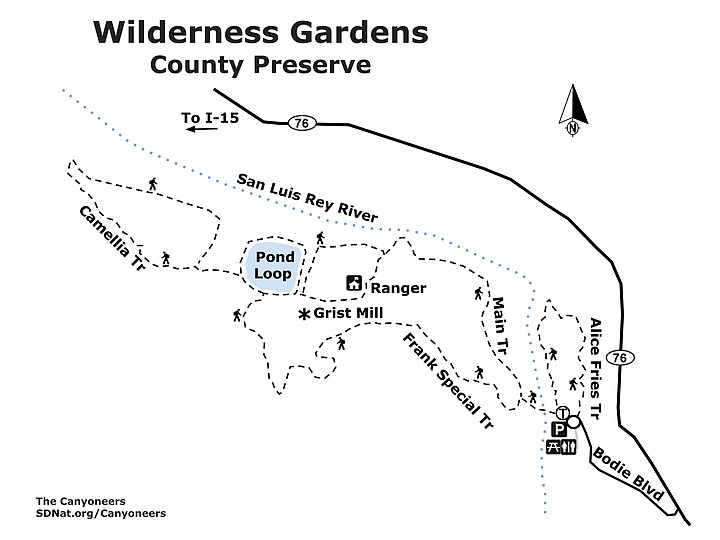 Facebook
Facebook
 X
X
 Instagram
Instagram
 TikTok
TikTok
 Youtube
Youtube

For a brief time in the 20th century, the Wilderness Gardens property was owned and named by Manchester Boddy, a Los Angeles politician, publisher, and horticulturist. For his “wilderness,” he dug five ponds, built greenhouses with an extensive irrigation system, and grew thousands of ornamental plants. Most of the ponds dried up and the irrigation system decayed after Boddy’s death, so when San Diego County took it over in 1973, it was decided to maintain the historical artifacts, including one pond, but to let most of the land revert to its native state, if not quite to an actual wilderness.
The Preserve is open from 8 am to 4 pm Thursday through Tuesday. It is closed on Wednesdays and for all of August. The best times to go are between October and June, preferably after a storm has left the area with clear air, and while some dramatic clouds remain. Rattlesnakes live here, and poison oak is abundant. The west hillside tends to face toward the morning sun, but Pala Mountain can provide late afternoon shade. There are five named trails in the Preserve.
A description of Wilderness Gardens Preserve was published in the Reader in August 2012. This write-up includes more detailed information about the trails and a name change for one of the trails.

The Alice Fries Trail begins just across from where you parked. This short, 0.5-mile loop trail is near the San Luis Rey Riverbed and goes through habitat known as alluvial scrub, filled with many rocks and boulders transported here by the river. The plants, widely scattered between the boulders, are typical of coastal sage scrub. These include California buckwheat (Eriogonum fasciculatum), chamise (Adenostoma fasciculatum), scabrid sweetbush (Bebbia juncea), yellow pincushion (Chaenactis glabriuscula), coast prickly-pear (Opuntia littoralis), and snake cholla (Cylindropuntia californica). Although most of the time you will be in the sun while hiking this boulder-lined path, there are also scattered large trees, including California sycamore (Platanus racemosa), coast live oaks (Quercus agrifolia), and western cottonwoods (Populus fremontii), which provide intermittent shade. You may also find the rare, tree-like flannelbush (Fremontodendron mexicanus), covered in large yellow flowers.
The most striking aspect of this trail is the massive wall of unconsolidated alluvium: boulders, water-rounded rocks of all sizes, gravel and sand that rises almost straight above you, cut by the river in fairly recent geological times. However, except after a rain storm, the riverbed rarely has any surface water because of the Lake Henshaw Dam, built in 1923, or diverted by the Escondido Canal, built in the late 19th century. Of course, some water continues to percolate through the riverbed underground and is available to plants with deep roots.
Completing the Alice Fries Trail loop brings you back to the main trail. Turn right on the main trail, cross the main river channel, which is almost always dry, and look to your left for the Frank Special Trail sign (aka Upper Meadow Trail). Frank Special was a San Diego native and a long-time employee of San Diego County Department of Parks & Recreation. His family decided to take advantage of a new “Naming Rights” program being offered by the County to honor Frank, who had passed away in 2015 and had worked hard to set aside Wilderness Gardens as a County preserve when he worked for the County.
The Frank Special Trail is nearly a mile-long trail that begins in alluvial scrub habitat but soon leads you through a shady oak woodland and up the chaparral-covered hillside. The most common flowering shrubs include yellow bush penstemon (Keckiella antirrinoides), holly leaf redberry (Rhamnus illicifolia), black sage (Salvia melifera), California sagebrush (Artemisia californica), mountain mahogany (Cercocarpus betuloides), chamise (Adenostoma fasciculatum), laurel sumac (Malosma laurina), deer weed (Acmispon glaber), and lemonadeberry (Rhus integrifolia). These shrubs are occasionally enshrouded with virgin’s bower (Clematis ligusticfolia) or wild cucumber (Marah macrocarpus) vines.
Visitors may see common wildflowers such as purple owl’s clover (Castilleja exserta) caterpillar phacelia (Phacelia cicutaria), collar lupine (Lupinus truncatus), bee plant (Scrophularia californica), and California poppy (Eschscholzia californica), as well as rarer plants such as blue toadflax (Nuttallanthus texanus), shooting star (Dodecatheon clevelandii), and fringe pod mustard (Thysanocarpus curviceps).
About half a mile into the trail, you will encounter a set of wooden steps leading up a steep incline of about 120 feet. From the top, you have an outstanding view across the river valley and down to the remains of the Sickler grist mill and pond. The trail then goes to the left and circles a depression that once held another pond, now completely dry. In the late 19th century when it was built, it stored water diverted from the San Luis Rey River, which was then used to power the mill.
Continuing on around the depression, the trail passes the upper meadow, a grassland with abundant non-native annual grasses and occasional wildflowers. After crossing a wooden bridge, the trail descends to the valley floor, ending near the Pond Loop Trail. On the way down, you pass a short trail on the left that loops through The Little Meadow, adding another viewpoint and place to explore, as well as 0.2-mile to your adventure.
The Pond Loop Trail circles around the remaining pond from Boddy’s “wilderness” and brings you back to your starting point on the main trail, a distance of about 0.3 mile. A dense growth of southern cattails (Typha domingensis) lines the banks, but there are occasional benches where you can sit and view open water. From there you may see northern shovelers, coots, and other waterfowl enjoying the pond.
The Camelia Trail takes you on another trip through alluvial scrub habitat. In addition to the species seen on the Alice Fries Trail, you can expect to find toyon (Heteromeles arbutifolia), blue elderberry (Sambucus nigra) and butterweed (Senecio californica). The trail is a 0.7-mile loop back to the Main Trail.
The Main Trail is actually the service road for the Preserve, mainly used by Preserve Rangers and maintenance vehicles. However, it also provides access to some of the historical sites and artifacts that document the history of human habitation of this valley. Native American encampments occurred here during the fall acorn collection season. Boulders found along this trail contain deep pits, or morteros, which were formed as acorns were stone ground for food year after year for thousands of years. The foundation of the Sickler’s grist mill, constructed here in 1881, is near the trail, as is its remaining water wheel. The mill used water power to turn a large grinding stone that turned local farmers’s corn and rye into flour. This trail also is the way back to your vehicle.

WILDERNESS GARDENS PRESERVE
Enjoy great diversity in habitats and native plants


For a brief time in the 20th century, the Wilderness Gardens property was owned and named by Manchester Boddy, a Los Angeles politician, publisher, and horticulturist. For his “wilderness,” he dug five ponds, built greenhouses with an extensive irrigation system, and grew thousands of ornamental plants. Most of the ponds dried up and the irrigation system decayed after Boddy’s death, so when San Diego County took it over in 1973, it was decided to maintain the historical artifacts, including one pond, but to let most of the land revert to its native state, if not quite to an actual wilderness.
The Preserve is open from 8 am to 4 pm Thursday through Tuesday. It is closed on Wednesdays and for all of August. The best times to go are between October and June, preferably after a storm has left the area with clear air, and while some dramatic clouds remain. Rattlesnakes live here, and poison oak is abundant. The west hillside tends to face toward the morning sun, but Pala Mountain can provide late afternoon shade. There are five named trails in the Preserve.
A description of Wilderness Gardens Preserve was published in the Reader in August 2012. This write-up includes more detailed information about the trails and a name change for one of the trails.

The Alice Fries Trail begins just across from where you parked. This short, 0.5-mile loop trail is near the San Luis Rey Riverbed and goes through habitat known as alluvial scrub, filled with many rocks and boulders transported here by the river. The plants, widely scattered between the boulders, are typical of coastal sage scrub. These include California buckwheat (Eriogonum fasciculatum), chamise (Adenostoma fasciculatum), scabrid sweetbush (Bebbia juncea), yellow pincushion (Chaenactis glabriuscula), coast prickly-pear (Opuntia littoralis), and snake cholla (Cylindropuntia californica). Although most of the time you will be in the sun while hiking this boulder-lined path, there are also scattered large trees, including California sycamore (Platanus racemosa), coast live oaks (Quercus agrifolia), and western cottonwoods (Populus fremontii), which provide intermittent shade. You may also find the rare, tree-like flannelbush (Fremontodendron mexicanus), covered in large yellow flowers.
The most striking aspect of this trail is the massive wall of unconsolidated alluvium: boulders, water-rounded rocks of all sizes, gravel and sand that rises almost straight above you, cut by the river in fairly recent geological times. However, except after a rain storm, the riverbed rarely has any surface water because of the Lake Henshaw Dam, built in 1923, or diverted by the Escondido Canal, built in the late 19th century. Of course, some water continues to percolate through the riverbed underground and is available to plants with deep roots.
Completing the Alice Fries Trail loop brings you back to the main trail. Turn right on the main trail, cross the main river channel, which is almost always dry, and look to your left for the Frank Special Trail sign (aka Upper Meadow Trail). Frank Special was a San Diego native and a long-time employee of San Diego County Department of Parks & Recreation. His family decided to take advantage of a new “Naming Rights” program being offered by the County to honor Frank, who had passed away in 2015 and had worked hard to set aside Wilderness Gardens as a County preserve when he worked for the County.
The Frank Special Trail is nearly a mile-long trail that begins in alluvial scrub habitat but soon leads you through a shady oak woodland and up the chaparral-covered hillside. The most common flowering shrubs include yellow bush penstemon (Keckiella antirrinoides), holly leaf redberry (Rhamnus illicifolia), black sage (Salvia melifera), California sagebrush (Artemisia californica), mountain mahogany (Cercocarpus betuloides), chamise (Adenostoma fasciculatum), laurel sumac (Malosma laurina), deer weed (Acmispon glaber), and lemonadeberry (Rhus integrifolia). These shrubs are occasionally enshrouded with virgin’s bower (Clematis ligusticfolia) or wild cucumber (Marah macrocarpus) vines.
Visitors may see common wildflowers such as purple owl’s clover (Castilleja exserta) caterpillar phacelia (Phacelia cicutaria), collar lupine (Lupinus truncatus), bee plant (Scrophularia californica), and California poppy (Eschscholzia californica), as well as rarer plants such as blue toadflax (Nuttallanthus texanus), shooting star (Dodecatheon clevelandii), and fringe pod mustard (Thysanocarpus curviceps).
About half a mile into the trail, you will encounter a set of wooden steps leading up a steep incline of about 120 feet. From the top, you have an outstanding view across the river valley and down to the remains of the Sickler grist mill and pond. The trail then goes to the left and circles a depression that once held another pond, now completely dry. In the late 19th century when it was built, it stored water diverted from the San Luis Rey River, which was then used to power the mill.
Continuing on around the depression, the trail passes the upper meadow, a grassland with abundant non-native annual grasses and occasional wildflowers. After crossing a wooden bridge, the trail descends to the valley floor, ending near the Pond Loop Trail. On the way down, you pass a short trail on the left that loops through The Little Meadow, adding another viewpoint and place to explore, as well as 0.2-mile to your adventure.
The Pond Loop Trail circles around the remaining pond from Boddy’s “wilderness” and brings you back to your starting point on the main trail, a distance of about 0.3 mile. A dense growth of southern cattails (Typha domingensis) lines the banks, but there are occasional benches where you can sit and view open water. From there you may see northern shovelers, coots, and other waterfowl enjoying the pond.
The Camelia Trail takes you on another trip through alluvial scrub habitat. In addition to the species seen on the Alice Fries Trail, you can expect to find toyon (Heteromeles arbutifolia), blue elderberry (Sambucus nigra) and butterweed (Senecio californica). The trail is a 0.7-mile loop back to the Main Trail.
The Main Trail is actually the service road for the Preserve, mainly used by Preserve Rangers and maintenance vehicles. However, it also provides access to some of the historical sites and artifacts that document the history of human habitation of this valley. Native American encampments occurred here during the fall acorn collection season. Boulders found along this trail contain deep pits, or morteros, which were formed as acorns were stone ground for food year after year for thousands of years. The foundation of the Sickler’s grist mill, constructed here in 1881, is near the trail, as is its remaining water wheel. The mill used water power to turn a large grinding stone that turned local farmers’s corn and rye into flour. This trail also is the way back to your vehicle.

WILDERNESS GARDENS PRESERVE
Enjoy great diversity in habitats and native plants